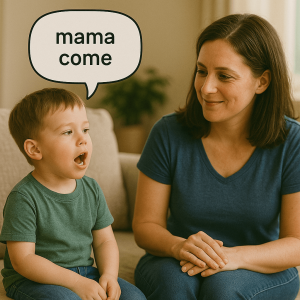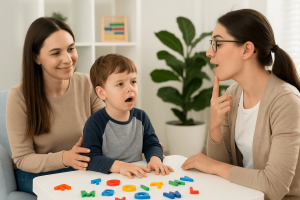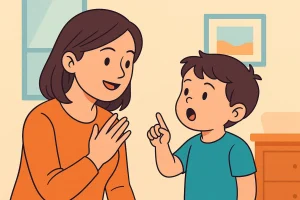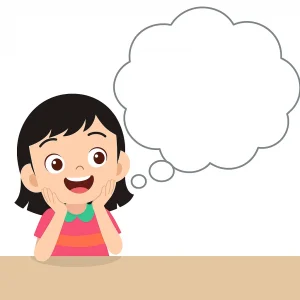Speech Therapy Strategies for Kids: Mastering CH Words
By Rajini D
Last Updated: October 24, 2024
Imagine sitting down with your child, eager to hear them say something simple like “chocolate” or “cheese,” but instead, they struggle, and those words come out as “ocolate” or “eeze.” Sound familiar? For many parents, this is a common part of helping their child master new speech sounds, especially the tricky “CH” sound. It’s more than just a small mispronunciation—these moments can affect a child’s confidence and their ability to communicate clearly with others.
The “CH” sound appears in so many fun, everyday words, but for young learners, it can feel like a mountain to climb. Whether it’s in casual conversations or during story time, mastering this sound is an important step in a child’s speech development. In this guide, we’ll explore simple, effective strategies that can make a world of difference in helping your child conquer the “CH” sound, boosting both their speech clarity and their confidence.
Also read: Help Kids Master the “CH” Sound
Understanding the CH Sound
Let’s explore the “CH” sound, a key part of many everyday words like “cheese,” “chicken,” and “watch.” This sound is important for clear speech, but it can be tricky for kids to master. Why? It’s all in how the sound is made.
Understanding the Complexity of the CH Sound
The “CH” sound is actually a mix of two sounds. First, there’s a quick “t” sound, and then it moves into a “sh” sound. This combination is what makes “CH” an affricate—starting with a stop in the airflow (the “t” sound), and then letting air pass through with some friction (the “sh” sound).
For kids, it can be hard to smoothly connect these two sounds. It’s not just about getting the “t” and “sh” parts right; they need to learn to blend them together quickly.
Example: A child might say “tocolate” instead of “chocolate,” or “shicken” instead of “chicken.” This shows they’re picking up on part of the sound, but need more practice connecting the two pieces. Parents and therapists can help by breaking the sound into smaller steps, practicing each part, and then bringing them together.
Also Read: Help Your Little One Perfect the ‘CH’ Sound: Expert Tips and Tricks
Here are some simple exercises to bring you and your little one closer to mastering the “CH” sound:
The Steam Train Game
Help your child think of the “CH” sound as a steam train getting ready to leave the station. The train starts with a slow “t” sound, just like a train getting ready to move. Then it speeds up with a “sh” sound, as if the train is picking up speed and zooming down the track. This playful comparison makes practicing the “CH” sound more exciting and memorable for kids.
Example: When practicing words like “cheese” or “chug,” encourage your child to imagine the sound of a train moving. This visualization makes it easier to blend the sounds, while keeping the exercise fun.
Also read: How to Help Your Child Pronounce the “Ch” Sound
Mirror Practice
Stand in front of a mirror with your child and say “CH” words together. Watch how your mouths and tongues move. This visual feedback helps kids understand how to correctly position their lips and tongue to make the “CH” sound. It’s like having a mini coaching session with instant feedback!
Example: If your child is struggling to say “chair,” point out how the tongue touches the roof of the mouth for the “t” and quickly moves for the “sh.” Practicing together while watching your reflections can help them improve.
Feather Fun
Turn the “CH” sound into a playful challenge by holding a feather in front of your child’s mouth. Encourage them to use the “CH” sound to blow the feather and make it float. This game not only teaches the correct sound but also helps them control their breath and airflow, which is key in speech development.
Example: Say words like “chew” or “chop,” and watch how the force of the sound makes the feather move. This interactive game keeps kids engaged while they learn.
Finding the “CH” Sound
During reading or TV time, make it a fun activity to listen for words with the “CH” sound. Every time your child hears a “CH” sound, they can clap, cheer, or even keep a tally of how many they spot. This exercise improves their ability to recognize the sound in different contexts, which reinforces their learning.
Example: While reading a story, pause when you come across a word like “chicken” or “beach.” Ask your child to identify the “CH” sound and repeat it aloud. The more they hear it, the more natural it will feel.
Sweet Sound Shifts
Make practicing the “CH” sound a tasty experience! Before snack time, have your child say a “t” sound, and after taking a bite, have them make a “sh” sound. This creates a playful, reward-based way to practice blending the two sounds.
Example: You can say, “First, we’ll make the ‘t’ sound like we’re getting ready for a treat, then we’ll switch to the ‘sh’ sound as we enjoy it!” Simple and fun activities like this help reinforce the sound change.
Why Some Kids Struggle with CH Sounds
Helping your child navigate speech development, especially with sounds like “CH,” can sometimes feel like piecing together a tricky puzzle. If your child is finding it hard to master this sound, rest assured that this is quite common, and many parents face the same challenge.
Common Reasons for Difficulties with CH Sounds
- Phonological Processes: Young children often simplify sounds as part of normal speech development. This is called a phonological process. For instance, they might drop the “t” part of the “CH” sound, so “chair” becomes “air.” It’s a natural stage, but sometimes kids need extra help to move beyond these simplifications.
Example: A parent might notice their child saying “air” instead of “chair” during storytime. In this case, the child is still learning to blend the sounds, which is where speech therapy can make a difference by focusing on the missing piece. - Late Development: Just like with other skills, children learn speech sounds at their own pace. Some kids pick up the “CH” sound early, while others may take more time. Being a late bloomer in speech development is common, and it doesn’t always point to a bigger problem.
Example: If your child hasn’t mastered the “CH” sound by a certain age, it’s important not to worry immediately. With patience and guided practice, many late-developing children catch up in their own time. - Motor Skill Challenges: Producing the “CH” sound is more complex than it might seem. It involves coordinating the lips, tongue, and breath, much like learning a new dance move. Children who struggle with motor skills may also find it hard to coordinate these movements for speech sounds.
Example: A therapist working with a child might notice that the child can say “t” or “sh” separately, but struggles to combine them. Targeted exercises can help improve their speech motor coordination over time. - Hearing Issues: If a child isn’t hearing speech sounds clearly, they might struggle to replicate them. Hearing problems, even mild ones, can affect their ability to pick up the finer details of sounds like “CH.” Early detection of hearing issues can prevent speech delays.
Example: A parent may notice their child mishearing or mispronouncing words, like “chair” as “shair.” If hearing difficulties are suspected, it’s a good idea to get their hearing checked, as early intervention can support both speech and language development.
Also read: Speech Sound Disorders: Causes, Treatment and Strategies
Embracing Improvement with the Right Strategies
If you’re feeling worried about your child’s difficulties with the “CH” sound, don’t be! With the right support, most kids can improve their speech. Here’s how:
- Early Intervention: The earlier you get help for your child, the easier it is for them to catch up. Programs designed for early speech support can make a big difference in your child’s progress.
Example: If your child is struggling with “CH” sounds, seeing a speech therapist early can help them start working on it right away, giving them a better chance to improve quickly. - Speech Therapy: Speech therapists know how to help kids with speech problems. They can figure out exactly why your child struggles and teach them fun, effective ways to practice and get better.
Example: If your child says “ticken” instead of “chicken,” a therapist might use games to help them learn the correct sound. Over time, your child will get better with practice. - Home Support: You can make a big difference at home with simple, fun activities. Practicing “CH” sounds during everyday moments, like reading or talking, can help your child improve.
Example: Spend a few minutes each day practicing words like “cheese” or “chair” with your child. Make it fun, and celebrate when they get it right! - Patience and Positivity: Every child learns at their own pace. Celebrate the small steps, and keep a positive, encouraging environment for your child. Your support makes a huge difference!
Example: When your child finally gets a “CH” sound right, give them lots of praise. Little victories add up and keep them motivated.
Strategies for Mastering CH Words
Helping children master the “CH” sound doesn’t have to be complicated. Whether you’re a parent, caregiver, or teacher, using fun and simple strategies can make learning enjoyable and effective. Let’s explore different methods that work for various learning styles, so every child can succeed in mastering the “CH” sound.
Awareness and Discrimination Activities
Before children can say the “CH” sound correctly, they need to hear it clearly. These activities help them recognize and distinguish the sound from others.
- Sound Scavenger Hunt: Turn everyday moments into a fun game! As you walk around the house or outside, look for things that contain the “CH” sound, like “chair” or “lunch.” Celebrate together when they find one, turning listening into an exciting adventure.
- Musical CH: Play songs that contain “CH” sounds and pause occasionally. Ask your child to listen carefully and identify the “CH” sound or word. This activity sharpens their listening skills while keeping them entertained with music.
Articulation Exercises
Articulation is all about how children physically produce the “CH” sound. These exercises make practicing fun and easy.
- Mirror Time: Let your child watch their mouth in a mirror as they say “CH” words. Seeing how their lips and tongue move helps them learn how the sound is made. For example, you can say “chop” or “cheese” and ask them to mimic your movements.
- CH Sound Isolation: Start by practicing just the “CH” sound on its own—“ch…ch…ch…” Then, slowly build up to syllables, words, and sentences. Begin with simple words like “chip” or “chop” and gradually move to sentences like “Chop the cheese.” It’s a step-by-step approach that makes it easier for kids to grasp the sound.
Fun and Games
Learning doesn’t have to feel like work. These games make practicing “CH” words part of the fun!
- CH Word Bingo: Create a bingo game with “CH” words and pictures. As you call out the words or show the pictures, kids can mark their bingo cards. This game reinforces “CH” words while keeping kids excited about learning.
- Craft with CH: Get creative by making crafts related to “CH” words. For example, you could create a paper “chick” or make a “cherry” collage. This hands-on approach combines fun activities with speech practice.
Using Technology
There are many online tools and resources that make practicing “CH” sounds more interactive.
- Educational Apps: Use speech development apps that give children instant feedback on their “CH” sound practice. These apps make learning feel like a game and keep kids motivated.
- Online Stories and Videos: At Wellness Hub, you can find stories and videos that focus on “CH” words. Watching and listening to these resources provides a rich visual and auditory experience, helping children practice in a fun and engaging way.
Activities to Practice CH Sounds
| Activity Type | Activity Description | Expected Outcome |
|---|---|---|
| Listening Games | Engage in “Sound Detective” games where the child listens for CH sounds in conversations, TV shows, or while reading together. Use a “Sound Jar” to collect items that start with the CH sound. | Enhances the child’s ability to discriminate CH sounds from other sounds, improving auditory processing and awareness. |
| Articulation Exercises | Use a mirror to practice CH sounds, encouraging the child to watch how their mouth and tongue move. Start with the sound on its own, then in simple syllables (e.g., “cha”, “che”, “chi”), progressing to words and phrases. | Directly improves the accuracy of CH sound production by providing visual feedback and allowing for self-correction. |
| Fun and Games | CH Word Bingo: Create bingo cards with images or words containing the CH sound. Crafts with CH: Make art projects based on CH words, like “cherry” paintings or “church” models. | Makes the learning process enjoyable and effective by integrating CH sound practice into creative and playful activities. |
| Technology Use | Introduce educational apps and online games focused on CH sound pronunciation and recognition. Look for interactive stories that highlight CH words and encourage repetition. | Supplements traditional learning methods with engaging, interactive content, offering diverse approaches to mastering CH sounds. |
Engaging Activities at Home
Creating a fun and supportive environment at home for practicing “CH” sounds can be incredibly helpful. These activities will not only make practice enjoyable but also help your child improve their speech skills naturally.
- Cooking Together: Turn kitchen time into “CH” practice! Pick recipes that include ingredients like “chocolate chips” or “cheese,” and as you cook, emphasize the “CH” sound.
Example: While making cookies, you can ask your child to say “chocolate chips” every time they add them to the batter. This makes learning part of a fun, everyday activity. - Storytime with a Twist: Choose books that are full of “CH” words or make up your own stories together. As you read, point out the “CH” words and encourage your child to say them aloud.
Example: Read a story about a “cheerful chick” or a “chocolate cake,” and pause whenever you come across a “CH” word. Ask your child to repeat the word after you, helping them practice in a relaxed setting. - Treasure Hunts: Make practicing “CH” words exciting by creating a treasure hunt around the house. Hide objects that start with “CH,” like a “chair,” “chalk,” or “chicken” toy, and have your child say the word when they find it before moving to the next clue.
Example: You can give your child a hint like, “Find the object you sit on (chair),” and once they find it, they say the word before moving on. This turns speech practice into a playful adventure.
Conclusion
Mastering the “CH” sound is an exciting journey for kids, and with patience, fun activities, and the right support, your child will improve their speech skills. Keep practice fun with games, crafts, and everyday conversations to make learning enjoyable. If you need more help, Wellness Hub offers expert advice and personalized speech therapy to guide your child every step of the way. Celebrate the small victories, and watch your child grow in confidence and clarity!
Frequently Asked Questions:
1. What age should a child master the CH sound?
Most children should be able to produce the CH sound correctly by the age of 3.5 to 4 years. However, some children might take a little longer, and that’s perfectly okay. Every child’s speech development journey is unique.
2. How can I help my child pronounce CH sounds at home?
Engaging in simple, playful activities that emphasize the CH sound can be very effective. Try games, crafts, and reading stories together that feature CH words. Remember to make it fun and stress-free.
3. Why is my child struggling with CH sounds?
Difficulties with CH sounds can stem from various reasons, including late speech development, phonological processes, or motor skill challenges. If you’re concerned, consulting a speech-language pathologist can provide you with personalized advice.
4. Can technology help my child with CH sound pronunciation?
Yes, there are many educational apps and online resources that provide interactive ways for children to practice speech sounds, including CH. These tools can complement traditional speech therapy and home practice.
5. When should I seek professional help for my child’s speech development?
If your child is significantly behind their peers in speech clarity, shows frustration with communication, or has consistent mispronunciations beyond the typical age of acquisition, it might be time to consult a speech-language pathologist.
6. How does Wellness Hub support children’s speech development?
Wellness Hub connects families with professional speech therapy services, offering access to expert advice, personalized support, and a variety of resources designed to support children’s speech development.
7. What are some simple exercises to practice CH sounds?
Simple exercises like mirror practice to observe mouth movements, sound isolation (repeating the CH sound on its own), and playing listening games to identify CH sounds in words can be very helpful. These activities can easily be incorporated into daily routines.
8. How long does it typically take for a child to master the CH sound?
The time it takes for a child to master the CH sound can vary widely. While some children might grasp it quickly, others may need more time and practice. Consistency and patience are key, along with regular practice and, if necessary, professional guidance.
9. Are there specific games that can help my child with CH sound pronunciation?
Yes, games like “Sound Scavenger Hunt,” where you find objects that start with the CH sound, or “CH Word Bingo,” can make learning engaging and effective. Tailoring games to your child’s interests can also boost their motivation to participate.
10. Can difficulties with CH sounds impact my child’s academic performance?
Speech sounds play a crucial role in clear communication, literacy, and learning. Difficulties with CH sounds can sometimes affect reading and spelling. However, with early intervention and support, children can overcome these challenges and thrive academically.
About the Author:
Anuradha Karanam
Speech-language pathologist (7+ years of experience)
Anuradha Karanam is a skilled speech-language pathologist with over 6 years of experience. Fluent in Tamil, Telugu, Hindi, and English, she specializes in parent counseling, speech sound disorders, fluency assessment, and speech-language evaluations. Anuradha excels at working with children with developmental disorders, offering creative and effective therapy programs. Currently, at Wellness Hub, she holds a BASLP degree and is registered with the RCI (CRR No A85500). Her patience, ambition, and dedication make her a trusted expert in her field.
Book your Free Consultation Today
Parent/Caregiver Info:
Client’s Details:
* Error Message








